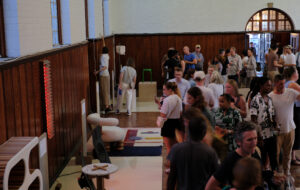The pair has teamed up to launch the Terra Carta Design Lab, inviting students from the Royal College of Art to develop solutions to the climate crisis

Words by Francesca Perry
The country is in the heightened throes of a deadly and mismanaged pandemic, the world is burning (and melting, and flooding), and the minute we feel any sense of hopeful community, racist men (and it is typically men) ruin everything.
Fear not though, because the besuited HRH Prince of Wales and multi-millionaire tech-designer Jony Ive will save us! The two have teamed up for a design project that on its surface sounds wholesome and noble enough: the Terra Carta Design Lab, which invites students to develop ‘credible and sustainable solutions’ to the climate crisis, from restoring biodiversity to reducing greenhouse gases.
In collaboration with the Royal College of Art (RCA), where Ive is chancellor, the design lab is for students of the RCA only – across the disciplines of architecture, design, engineering, history and art. The project forms part of the Sustainable Markets Initiative (SMI), set up by Prince Charles in 2020 as a network of global CEOs working towards ‘prosperous and sustainable economies that generate long-term value.’ The launch of the new project comes 100 days in advance of COP26, the United Nations Climate Change Conference to be held later this year in Glasgow.
When I saw Ive – former chief design officer at Apple – had partnered with our future king, I groaned. Of all the British design forces for Ive to align with, Prince ‘Poundbury’ Charles – proponent of nostalgia-driven classical architecture for lovers of traditionalism – is surely not the wisest of choices. The initiative is, at least, nothing to do with returning the UK’s cities to white-washed hubs of limestone porticos and tipped hats. But closer inspection reveals myriad issues.
First up, there is a thin line between supporting emerging design talent, and relying on young, unpaid labour to generate the solutions the grown-ups in charge should have implemented years ago. The winning designs – which are required to be low-cost and high-impact – will eventually receive financial support for further development, and mentoring from Ive and SMI, but as anyone who has ever entered a design or architecture competition can attest, there is a lot of work – and free sharing of intellectual property – in the lengthy process to reach such an elusive goal.

Second, it is hard not to see this as a royal campaign of greenwashing. ‘Look, we know the monarchy is inherently problematic,’ I imagine the subtext to say. ‘We promise we care about the planet. No no, forget the environmental and social impacts of colonialism, we’re ok now.’ Perhaps this is designed to attract international investment to the UK, from those good old global CEOs (SMI partner companies include Bank of America, Amazon and Shell), with a PR sheen that benefits everybody.
Third of all, let’s look at the project launch video. What would convince people that this is an inclusive initiative that tackles the climate crisis head on? Having Ive and HRH walk in slow motion through the Highgrove House royal estate in summer suits, enjoying the exclusive greenery, of course! Prince Charles has nice gardens so clearly will take bold steps to mitigate climate change. Logic.
Perhaps I’m being overly negative. After all, the SMI’s Terra Carta, launched in January 2021 and after which the design lab is named, is a charter and ‘roadmap to 2030’ for businesses, which places nature, people and planet ‘at the heart of global value creation.’
It is true, because of our relentless capitalist system, that if we want big companies to start acting truly responsibly and sustainably, we need to make the economic case for – quite literally – cleaning up their act. To make clear that environmental protection is good for the bottom line (in the long term it is, of course; few companies have the foresight to embrace that). But I don’t quite see, beyond the aspirational ‘roadmap’ (word of 2021, anyone?), how these companies will be held to account, and what commitments they are really making. Easier just to do a fun student-led design project, I guess.
In 1994, speaking on architecture and society, Prince Charles warned against the avant garde becoming so dominant that it ‘becomes the establishment’. Now he is seemingly trying to unite the two. If we continue to operate on establishment principles, the world as we know it is doomed. It remains to be seen what this new drive towards design innovation through an undeniably establishment lens will achieve.
















